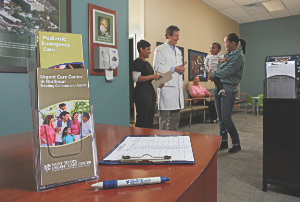Urgency, Not Emergency
Convenient and versatile, a newly popular type of facility fills the gap between your doctor’s office and an emergency room

If you’ve been to a hospItal emergency room in recent years, you know that such facilities are under a lot of pressure. People who lack health insurance some- times use the ER as a doctor’s office, while others—even if they have a regular doctor—show up seeking after-hours treatment for problems that don’t qualify as true emergencies but do deserve prompt handling. Mix all these folks in with the suddenly injured or very sick, and it’s no surprise that long waits are always a possibility.
Now there’s another option. “Urgent care” centers have become one of the hottest trends in healthcare delivery over the past decade across the nation—including in new Jersey, where saint Peter’s Healthcare system recently opened its first urgent care center in Skillman.
Urgent care centers offer an “in-between” alternative to both emergency rooms and appointments with primary care providers. And they’re an answer to the difficulty of finding same-day care or after-hours care.
“You see urgent care centers on most major highways these days,” says Heather Veltre, R.N., M.A.S., director of emergency services for saint Peter’s, which opened the skillman center in The Village shoppes at Montgomery on Route 206 in January 2012. “People want immediate access to health care, and we wanted to provide a service to this community because there was no urgent care in the area,” Veltre says.
Though they don’t stay open 24/7 as emergency rooms do, urgent care centers are open beyond typical doctor’s office hours, including holidays, and their scope of services is broader than that of many primary care offices and more similar to an ER. In fact, the Skill- man center is managed by the same staff that runs the Saint Peter’s Emergency Department and is staffed with a board- certified emergency medicine physician at all times. These physicians are specially trained to handle the acute illnesses and injuries that are seen in an ER.
Because they’re not vying for priority with severe emergencies, patients tend to get prompt attention. “Here they have zero or little wait time,” says Frank J. DiSanzo, chief information and strategy officer for Saint Peter’s. There’s more of a customer focus, with a large reception area and lounge decorated like a typical doctor’s office. And one of the most important differences between urgent care and the ER is cost. Depending on insurance coverage, the copay can be two to four times higher at an ER than at a center like this.
For true emergencies (see “Is It an Emergency?”), the ER is still the best place to go for care. But for just about any non–life-threatening illness or accident, urgent care is perfectly positioned to provide treatment. Besides the physician, the Skillman center is always staffed with a nurse, a radiology technician, a lab technician and a medical assistant. There are four examination rooms, an imaging room with X-ray equipment and a laboratory to process blood tests, throat cultures and other simple tests. With that in place, the center can diagnose and treat broken bones, stitch up lacerations, treat animal and bug bites and, most commonly of all, attend to upper respiratory infections such as the flu. “We see a lot of kids with fevers,” Veltre says. During flu season the center’s patient load more than doubles, to 40 to 50 a day, she says.
First urgent care center after the University Medical Center at Princeton, which normally served this region of New Jersey, moved to Plainsboro. “The community approached us about the need, and we stepped up to the plate and put a center in,” says DiSanzo. “It has been extremely well received. The patient volume has exceeded our expectations and is trending upward.” That success has prompted Saint Peter’s to consider opening more centers in Somerset and Middlesex counties over the next 12 to 24 months, he says.
The center also hopes to expand its services by working with area schools and businesses to provide testing, screenings and physicals for things such as sports camps, workers’ compensation cases and public health initiatives such as flu shots. “We are also looking to become a venue for local physicians to give presentations about their practices and services,” DiSanzo says. “We want a symbiotic relationship with area physicians. This is not about taking their patients away. It’s about supplementing their care with after-hours support.”
And it’s the kind of support patients can truly appreciate. “What makes us unique is customer service,” Veltre says. “We are focused on the patients’ experience. We make sure they are treated quickly, with respect, and leave with a better understanding of their problem and how to treat it.”
IS IT AN EMERGENCY?
What, exactly, is a medical “emergency”? The American College of Emergency Physicians (ACEP) says these are the warning signs of a true emergency that should be treated immediately in an ER:
– difficulty breathing, shortness of breath
– chest or upper abdominal pain or pressure
– fainting, sudden dizziness, weakness
– changes in vision
– confusion or changes in mental status any sudden or severe pain uncontrolled bleeding
– severe or persistent vomiting or diarrhea
– coughing or vomiting blood suicidal feelings
– difficulty speaking shortness of breath unusual abdominal pain
SHOULD YOU CALL 9-1-1?
If an emergency is life-threatening or if you’re unsure if it is life-threatening, call 9-1-1, the ACEP says. If it is not life-threatening, it may be more cost- effective to find someone to drive the person or take him or her in a taxi to the hospital or doctor. However, consider the following:
Could the individual’s condition worsen and become life-threatening on the way to the hospital? Could moving the person require the skills or equipment of paramedics or emergency medical technicians? Would distance or traffic conditions cause a delay in getting the victim to the hospital?
One special caveat: If you suspect a spinal injury, do not move the victim. Call 9-1-1 and wait for help to arrive.
Where to go:
Saint Peters’ Urgent Care Center
The Village shoppes at Montgomery 1378 Route 206, Skillman 609.497.4597
OFFICE HOURS:
Monday through Friday, 8 a.m. to 8 p.m.
Saturday, Sunday and holidays, 10 a.m. to 6 p.m.
For more information, go to saintpetershcs.com/urgentcare


